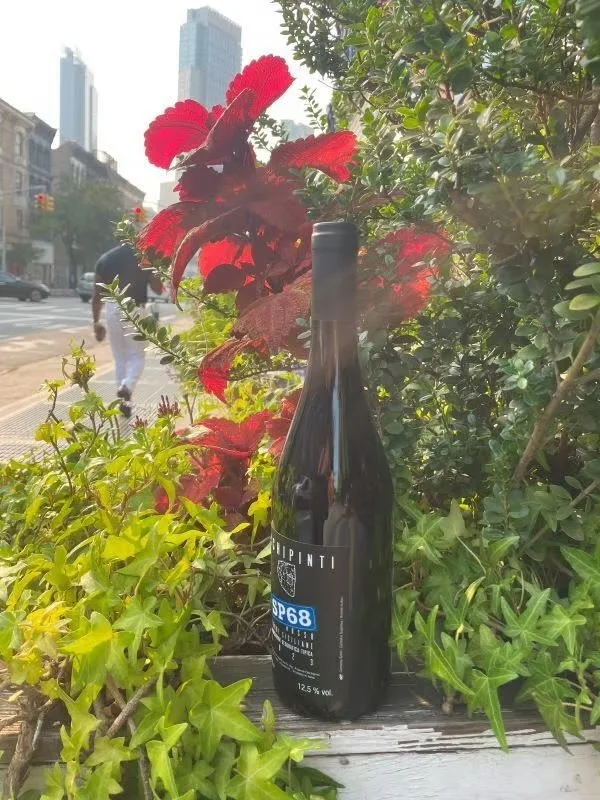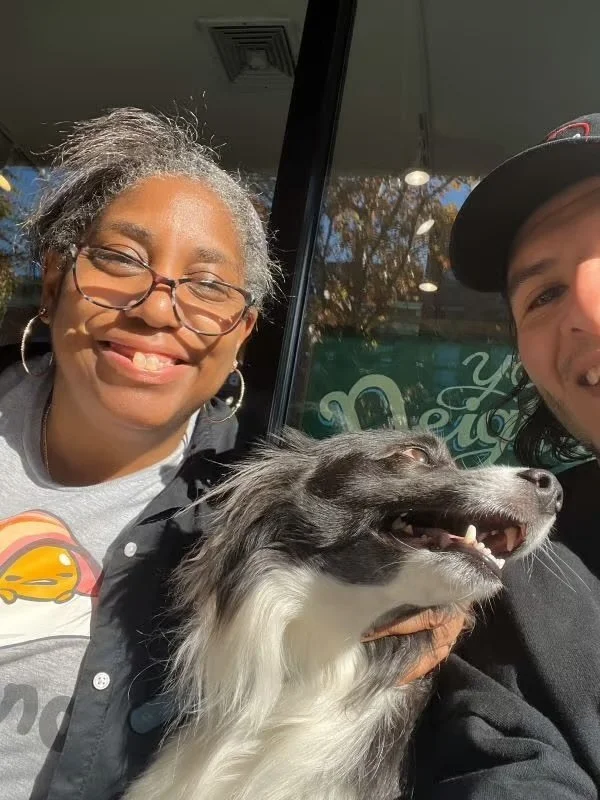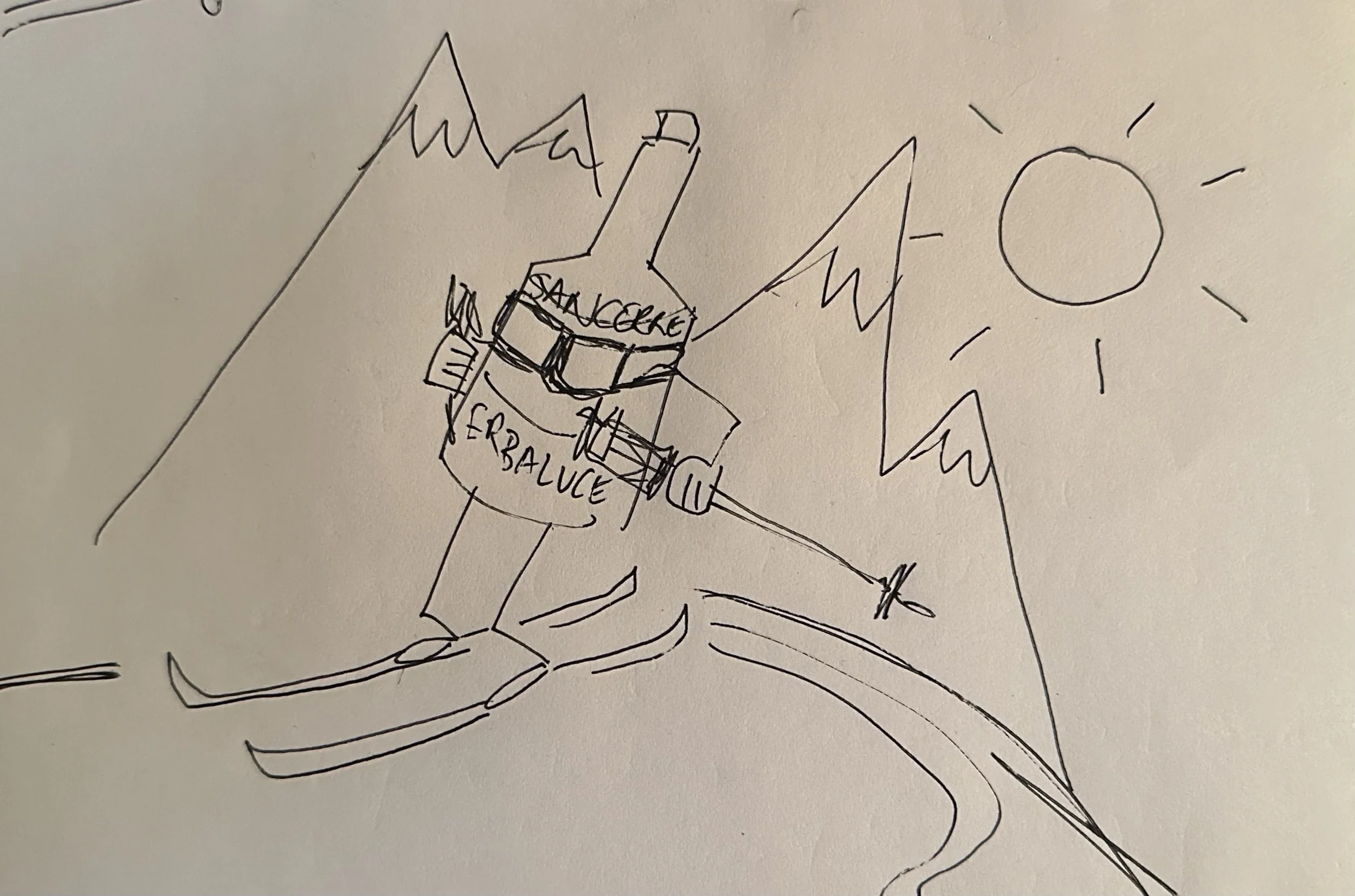Meet Michele Thomas
Michele Thomas in her element with a bottle of Frecciarossa Giorgio Oddero Pinot Nero. Yum!
Hi, I’m Michele! Like my friend Rose Thomas, I live in Brooklyn, New York. But unlike RT, I also grew up in Brooklyn, with the diverse sounds, languages, and stories of New York City all around me.
I started writing as a little girl on the old Smith-Corona typewriter I found in my mom’s closet. Today, I work as a writer, educator, and full-time wine buyer (which is how I met Rose Thomas, but we’ll come back to that).
I have degrees in Communication and Journalism, as well as Creative Writing, and have studied French cooking, Pastry Arts, and wine at the French Culinary Institute (R.I.P.), before becoming a Certified Sommelier. My writing has appeared in The New Yorker, Edible Brooklyn, Edible Manhattan, a bunch of culinary textbooks, and a book to two of my own, most notably Culinary Careers for Dummies (Wiley, 2011).
When I met RT, she was a wine rep, and I was pretty new to the wine business. She would come by Greene Grape, the Brooklyn wine shop where I work, with a bag full of wine and stories — you can think of them as little bios — for each one. In no time, we clicked over our shared love of language, travel, and of course, wine. However, what sealed the deal was one particular Barbera d’Alba. A regal ruby color, it smelled of crushed roses, cherry blossoms, fennel and one more thing I was trying to sniff out with my nose in the glass when suddenly, mortifyingly, my glasses slipped off my face and into the spit bucket, which was filled with about 3 inches of wine backwash. I remember feeling frozen in time and embarrassment for a second, and then the sounds of laughter, as Rose Thomas and I cackled at the ridiculous moment. A friendship was born.
RT & MT
A Day at the Shop
My day begins hours before the first customers arrive, with coffee, a decidedly non-alcoholic aperitivo. “Go-Go Juice,” my mother used to call it. Dark and a little bitter, the ritual and the taste work together to get my mind ready for the day ahead. I keep the lights dim for a bit, savoring the quiet, I tell myself, but it’s just as useful for figuring out the musical vibe of the day. For a small shop like mine, and indeed for any retailer, the vibe created by background music is pretty important. So much so that the effect of music on customers has been studied for decades. The right music is also helpful for me as I focus on everything from order and sales reports to website maintenance, pursuing new business, dispatching staff on deliveries, and writing tasting notes for each and every wine and spirit in the shop. But first, coffee.
My desk, on any given day, but especially during OND
During that first cup of coffee at the shop, I wander the sales floor, taking note of what needs replenishing, and strategizing about what holes I have to fill. Is there room for Greco di Tufo in the Italian section? Should I find another orange wine from California? I take notes, prioritizing tasks for the day. Then, I sit down, put on some tunes — I’m partial to Old School hip hop and soul, but everyone loves Fleetwood Mac — and get to work. I have how many emails?
The stock team leader comes in first, usually an hour after me, and we chat about the day’s delivery schedules, orders going out to customers, and products coming into the shop. This will be one of our busier days, by the looks of things.
Styling photos outside of the wine shop
The sun is out on Fulton Street, so I grab the camera and take a few photos for the store’s website and social media. Posing bottles on the street, I run into colleagues from Provisions, the grocery market next door, the owner of the restaurant down the street, Ralph, the hardware store guy, and even a few customers out on a stroll with their dogs (I keep a few Milk Bones in my pocket for just such an emergency).
Moments with customers like Mozzie, seen here with Kenneth, one of his owners
The first deliveries of the day arrive, and I step back inside to count and sign off on what’s arrived before the stock team loads the bottles into the store’s temperature-controlled cellar. I load the paperwork into our inventory system. The pace of the day is starting to pick up. Our Sales Associates are arriving soon, as are wine reps for the day’s first tasting appointments. The store will be open in 20 minutes. I have just enough email time to help a client choose wine for an reception. How many folks? How many hours? These are the key questions that help us settle on a total of 18 bottles for 25-ish people.
It’s noon. With a flip of a sign, the store is open and the first regulars come in—the barber for a nip of Fernet-Branca (this guy has amazing style), the gardener for a bottle of Gruner Veltliner and a chat about books, trips, or recipes. Wine Rep #1 comes in trailing a wheeled suitcase of wines, and maybe a whiskey or two.
“Hey, how you doing?” I say. It sounds more like “hey-ow-you-doo-inn.” No matter where I am, my Brooklyn accent shows up when I say hello. I usher them into the back of the shop, where my desk is. With practiced finesse, they maneuver around the registers, past the liquor boxes, into the office.
“Pretty good,” they say. “How’s things? Business good?”
“Yeah, pretty busy!” I say. “It’s that time of year.”
“Is it January yet?” They say, and we chuckle darkly in OND — the wine trade’s acronym for October, November, and December, the busiest, most hectic months in the hospitality business. Just about 25% of wine and spirits sales in the U.S. take place during those three months. Everyone is frantically trying to buy and sell as much as possible before closing the books on the calendar year. January, when the parties end, and folks go “dry” for a month, is a chance for the professionals to rest, reset, and go home early.
“Whatcha got today?” I say, grabbing my tasting glass and a spit bucket. I am suddenly very conscious of my glasses.
The rep puts the lineup on my desk, or a sturdy box nearby— this is New York, after all. Who’s got a big office? If it’s their first tasting of the day, the rep may taste with me to see how the wines are showing. Like people, wines have their good days and off days.
We start with the whites. Tasting pours are small, usually an ounce or so. The reasons for this are two-fold. Nobody needs to get tipsy at noon, and because the reps are also showing the wine at other stores and restaurants. Tasting bottles need to last all day, just like the reps and buyers who are sampling them.
I assess the color and clarity of the wine first. How does it look in the glass? Does it sparkle and reflect the light? I imagine how it would look in a dimly lit dining room. Next, my nose gets to work looking for faults like cork taint, but also for the story this wine is trying to tell. I sniff for fruit notes and other keys to the terroir and winemaking, hints of soil and vegetation, flowers, herbs, moss, river stones and salty sea spray. Clove and vanilla let me know if the wine has spent time in oak barrels, their absence that the winemaker chose stainless steel to preserve the purity of the fruit.
Tasting goes like this: The first sip is to feel the wine. Does it swish like silk against my teeth and cheeks, or is there a grip? Is it creamy? The more my mouth waters, the higher the acidity and zestiness. I swish the wine about in my mouth before shooting it out as a small stream into the spit bucket. Reflexively, I push my glasses up my nose.
The second sip is about flavor and feeling. Does this wine taste the way it smells? Do the flavors linger? Are they shy? I imagine the wine as a personification of itself. Crisp and professional, like Sancerre on a ski vacation? Sounds like Erbaluce to me. I ask myself if I can sell this, and more importantly, is it right for the customers I see daily or weekly, going to brunch and birthday parties, provisioning themselves for an evening of “Vanderpump Rules” or just hanging out after dinner. These are not things to be taken lightly. I want to help my customers have a good time, no matter what they’re doing. I spit again.
Never heard of Erbaluce? Imagine Sancerre on a ski vacation!
[Illustration by Giulia Àlvarez-Katz]
Then I ask myself if the bottle fits the store’s mission to showcase wine and spirits made by small, independent makers, farmers, and families around the globe. It’s not an easy question. Sometimes the answer doesn’t come to me right away. Sometimes, the answer is not what I want it to be, but I’m okay with that. I have to be. Otherwise, I’m just buying for myself and not for my customers—who are also my neighbors and friends.
I take a swig of water. I sniff something that’s not wine to reset my nose. My cup of coffee, perhaps, or the sleeve of my sweater. The rep opens another bottle, a red this time, and we begin again. I make extra sure my glasses are secure.






